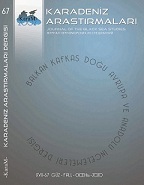OSMANLI-HABSBURG HUDÛD TAHDÎDİNE BİR ÖRNEK: ZİŞTOVİ SONRASI BOSNA HUDÛDUNUN TAFSİLATI (27 ARALIK 1795)
AN EXAMPLE OF THE OTTOMAN-HABSBURG BORDER JURISTICTION: THE DETAILS OF THE BOSNIAN BORDER AFTER THE SISTOVA (27 DECEMBER 1795)
Author(s): Mehmet SolakSubject(s): Geography, Regional studies, Political history, 18th Century, The Ottoman Empire, Geopolitics
Published by: Karadeniz Araştırmaları Merkezi
Keywords: Ottoman Empire; Habsburg Monarchy; Bosnia; Croatian; Frontier;
Summary/Abstract: The Ottoman-Austrian War of 1787-1791, the third struggle between the Ottoman and Habsburg political forces in the 18th century, ended with the treaty signed in the Bulgarian town of Sistova on August 4, 1791. An additional treaty was signed on the same date as the Sistova treaty did not specify the Ottoman-Habsburg borders in Bosnia and Croatian territory. A committee to define the borders was established to translate the decisions with the borders in the two treaty texts signed in Sistova; The commission was able to complete its work four years later, on 27 December 1795. A text stating the detailed directions of the Bosnian borders determined by the Commission was written and this official document was recorded in the Ottoman archive records. In the context of this document titled “The details of Bosnian Border after Sistova” in 1795, the Habsburg Monarchy won the settlements of Dvor, Drežnik, Cetingrad, Petrovo Selo, Lapac, Srb, Boričevac, Dobroselo, Doljane, Kupirovo, Osredci, Suvaja and Tiškovac in the Croatian geography whereas the Ottoman Empire obtained Bosanska Nova, Bosanska Gradiška and Bosanska Dubica in Bosnia geography. This border has formed the basis of the current border between Croatia and Bosnia and Herzegovina. In this study, the document titled “Post-Sistova Bosnian Border” was examined. In the context of the document, the arrangement of the Bosnian border was tried to be revealed in all its details. In the research, in addition to works related to Ottoman archival documents and literature, works published in Croatian, German and English were used. Content analysis, one of the qualitative research methods, was used.
Journal: Karadeniz Araştırmaları
- Issue Year: 2020
- Issue No: 67
- Page Range: 631-656
- Page Count: 26
- Language: Turkish

